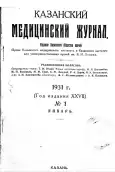К вопросу о классификации и номенклатуре хронических „ревматических“ суставных заболеваний
- Авторы: Гельман И.
- Выпуск: Том 27, № 1 (1931)
- Страницы: 23-33
- Тип: Статьи
- URL: https://bakhtiniada.ru/kazanmedj/article/view/79800
- DOI: https://doi.org/10.17816/kazmj79800
- ID: 79800
Цитировать
Полный текст
Аннотация
Каждая рациональная классификация закрепляет достигнутые в момент ее составления знание и понимание изучаемых явлений. Являясь формулировкой этого понимания, классификация в свою очередь становится исходным пунктом для дальнейшего движения вперед. Вот почему во время от времени необходимо пересматривать номенклатуру и классификацию изучаемых явлений, чтобы их поднять на уровень новых знаний, чтобы в них влить накопленные новые наблюдения. В клинической медицине классификации болезненных форм не могут, конечно, обладать точностью и определенностью, какую они имеют, напр., в математических науках. Недостаточное знание этиологических факторов, их множественность и интерференция, обилие переходных и сочетанных форм, компенсаторные приспособления, выравнивающие нарушения функций— все это чрезвычайно затрудняет каждый шаг на пути классифицирования. Однако, если нет данных для составления более или менее законченных классификаций, приходится нередко составлять рабочие классификации, имеющие заведомо лишь временное значение. Эти трудности классификации особенно нарастают, когда мы имеем дело с такими неясно дифференцированными болезненными явлениями, какими являются суставные заболевания. Здесь у практических врачей господствует невообразимая „путаница“ (Umber). Свое неумение разбираться в запутанных болезненных формах практические врачи топят в неопределенных диагнозах „ревматизм", „подагра“. Между тем то большое социальное значение, которое приобретают „ревматические“ заболевания суставов—социальные болезни par excellence—требует более тщательной дифференциации и учета суставных заболеваний, а последние возможны только при построении более или менее рациональной классификации.
Ключевые слова
Полный текст
Открыть статью на сайте журналаОб авторах
И. Гельман
Автор, ответственный за переписку.
Email: info@eco-vector.com
приват-доцент
Россия, МоскваСписок литературы
Дополнительные файлы





